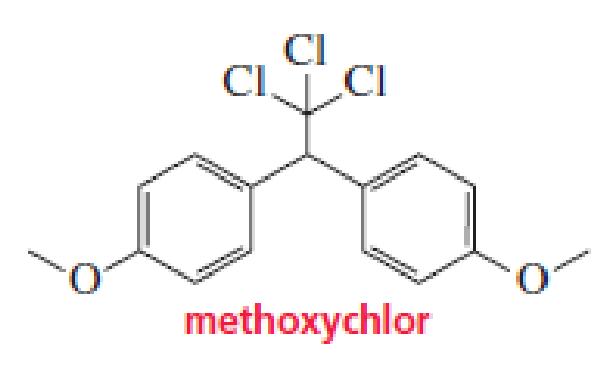
Methoxychlor is an insecticide that was intended to take DDT’s place because it is not as soluble in fatty tissues and is more readily biodegradable. It, too, can accumulate in the environment, however, so its use was also banned—in 2002 in the European Union and in 2003 in the United States. Why is methoxychlor less soluble in fatty tissues than DDT?

Interpretation:
The reason for methoxychlor is less soluble in fatty tissues than DDT has to be given.
Concept Introduction:
Compounds in which one or more hydrogen atoms are replaced by halogen atoms are called alkyl halides.
These alkyl halides usually undergo substitution or addition reactions.
The electronegative atom is replaced by another atoms or group are referred as substitution reactions.
The electronegative atom is eliminated along with a hydrogen from adjacent carbon is called elimination reactions.
Answer to Problem 1P
The methoxychlor can form hydrogen bonds with water. Thus it is less soluble in fatty tissues.
Explanation of Solution
Methoxychlor is a chemical compound. It has methoxy group instead of chlorine on the benzene ring in DDT (dichlorodiphenyltrichloroethane). These methoxy groups can form hydrogen bonds with water. Thus makes it more soluble in water than fatty tissues.
The reason for methoxychlor is less soluble in fatty tissues than DDT was given.
Want to see more full solutions like this?
Chapter 8 Solutions
EP ESSENTIAL ORG.CHEM.-MOD.MASTERING
- Which will evaporate faster, 1-Butanol or Pentane? Explain your choice.arrow_forwardUsing the equation below, what is the rate of this reaction if the rate of disappearance of H2 is 0.44 M/sec? H2 + Br2 → 2HBrarrow_forward2Fe3+(aq) + Sn2+(aq) □ 2Fe²+(aq) + Sn 4+ (aq) If the change in Sn²+ concentration is 0.0010M in 38.5 seconds, what is the rate of disappearance of Sn²+?arrow_forward
- For a neutral hydrogen atom with an electron in the n = 4 state, how many different energies are possible when a photon is emitted? 4 3 2 1 There are infinite possibilitiesarrow_forward2 NO(g) + H2(g) → N2(g) +2 H2O(g) If NO has rate of disappearance of 0.025 M/min, what is the rate of this reaction?arrow_forward2Fe3+(aq) + Sn2+(aq) □ 2Fe²+(aq) + Sn 4+ (aq) If the change in Sn2+ concentration is 0.0010M in 38.5 seconds, what is the rate of appearance of Fe²+?arrow_forward
- Using the equation below, if the rate of disappearance of Cl2 is 0.26 M/min, what is the rate of this reaction? 2NO(g) + Cl2(g) → 2NOCI(g)arrow_forwardA 45.0 mL solution containing a mixture of 0.0634 M KCN and 0.0634 M KCI is titrated with 0.107 M AgNO. From this mixture, which silver salt will precipitate first? A list of Ksp values can be found in the table of solubility constants. • AgCI • not enough information to determine AgCN What is the concentration of Ag* at the first equivalence point? [Ag*] = Will the second silver salt begin to precipitate at the first equivalence point before the first silver salt has completely precipitated? • not enough information to determine • yes • noarrow_forward[Review Topics] [References] Indicate whether the pair of structures shown represent stereoisomers, constitutional isomers, different conformations of the same compound, or the same conformation of a compound viewed from a different perspective. Note that cis, trans isomers are an example of stereoisomers. H₂N ✓ CI H₂N NH2 NH₂ CI Submit Answer Retry Entire Group 2 more group attempts remaining Previous Next>arrow_forward
- Don't used Ai solutionarrow_forwardDraw resonance structures for the following compounds. Please provide a thorough explanation that allows for undertanding of topic.arrow_forwardBF3 has a no dipole moment. a) Draw the Lewis structure for BF3, showing all nonbonding electrons. b) Indicate the polarity of every atom in the structure using δ+ and δ– notation, and explain why the molecule has no net dipole. Please provide a thorough explanation that allows for undertanding of topic.arrow_forward
 Organic ChemistryChemistryISBN:9781305580350Author:William H. Brown, Brent L. Iverson, Eric Anslyn, Christopher S. FootePublisher:Cengage Learning
Organic ChemistryChemistryISBN:9781305580350Author:William H. Brown, Brent L. Iverson, Eric Anslyn, Christopher S. FootePublisher:Cengage Learning
 Introduction to General, Organic and BiochemistryChemistryISBN:9781285869759Author:Frederick A. Bettelheim, William H. Brown, Mary K. Campbell, Shawn O. Farrell, Omar TorresPublisher:Cengage Learning
Introduction to General, Organic and BiochemistryChemistryISBN:9781285869759Author:Frederick A. Bettelheim, William H. Brown, Mary K. Campbell, Shawn O. Farrell, Omar TorresPublisher:Cengage Learning
 Chemistry for Today: General, Organic, and Bioche...ChemistryISBN:9781305960060Author:Spencer L. Seager, Michael R. Slabaugh, Maren S. HansenPublisher:Cengage Learning
Chemistry for Today: General, Organic, and Bioche...ChemistryISBN:9781305960060Author:Spencer L. Seager, Michael R. Slabaugh, Maren S. HansenPublisher:Cengage Learning Organic And Biological ChemistryChemistryISBN:9781305081079Author:STOKER, H. Stephen (howard Stephen)Publisher:Cengage Learning,
Organic And Biological ChemistryChemistryISBN:9781305081079Author:STOKER, H. Stephen (howard Stephen)Publisher:Cengage Learning,





